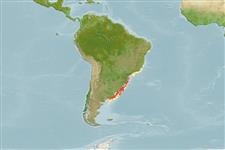Elasmobranchii (sharks and rays) >
Myliobatiformes (Stingrays) >
Myliobatidae (Eagle and manta rays)
Etymology: Myliobatis: Greek, mylo = mill + Greek, + Greek, batis,-idos = a ray (Raja sp.) (Ref. 45335); ridens: Name from Latin 'ridens' meaning laughing or smiling, referring to the peculiar countenance of this species caused by the corners and width of the mouth that resembles a smile.
Environment: milieu / climate zone / depth range / distribution range
Ecology
Marine; brackish; benthopelagic; depth range 5 - 47 m (Ref. 91774), usually 5 - 15 m (Ref. 91774). Subtropical
Distribution
Countries | FAO areas | Ecosystems | Occurrences | Point map | Introductions | Faunafri
Southwest Atlantic: Brazil to Argentina.
Size / Weight / Age
Maturity: Lm ? range ? - ? cm
Max length : 63.0 cm WD male/unsexed; (Ref. 91774); 70.0 cm WD (female)
Short description
Identification keys | Morphology | Morphometrics
This species is distinguished by the following set of characters: rhombic disc which is wider than long, width about 2.2-times TL; disc length 58%-64% of DW; anterior margin of disc joining head behind orbits; head clearly protruding from disc, eyes in lateral position, moderate in size; snout width equal to interorbital distance (13.6%-16.5% DW), mouth relatively wide, as broad as distance between 5th gill slits (mouth width 0.8-1-times distance between 5th gill slits); mouth width greater than distance between inner ends of nostrils (1.5-1.6- times); distance between 5th gill slits greater than distance between inner ends of nostrils (1.8-1.6-times) (Ref. 91774).
Male and female mature at approximately 50.0-60.0 mm DW (Ruocco, unpubl. data), and males are typically smaller than females (Ref. 91774).
Life cycle and mating behavior
Maturity | Reproduction | Spawning | Eggs | Fecundity | Larvae
Ruocco, N.L., L.O. Lucifora, J.M.D. de Astarloa, E. Mabragaña and S.M. Delpiani, 2012. Morphology and DNA barcoding reveal a new species of Eagle Ray from the Southwestern Atlantic: Myliobatis ridens sp. nov. (Chondrichthyes: Myliobatiformes: Myliobatidae). Zoological Studies 51(6): xxx-xxx. Two (Ref. 91774)
IUCN Red List Status (Ref. 130435: Version 2024-2)
Threat to humans
Harmless
Human uses
Tools
Special reports
Download XML
Internet sources
Estimates based on models
Preferred temperature (Ref.
123201): 13.3 - 23.6, mean 16.3 °C (based on 199 cells).
Phylogenetic diversity index (Ref.
82804): PD
50 = 0.5002 [Uniqueness, from 0.5 = low to 2.0 = high].
Bayesian length-weight: a=0.00389 (0.00119 - 0.01269), b=3.08 (2.83 - 3.33), in cm total length, based on LWR estimates for this (Sub)family-body shape (Ref.
93245).
Trophic level (Ref.
69278): 3.5 ±0.4 se; based on size and trophs of closest relatives
Resilience (Ref.
120179): Low, minimum population doubling time 4.5 - 14 years (Preliminary low fecundity).
Fishing Vulnerability (Ref.
59153): Very high vulnerability (83 of 100).
